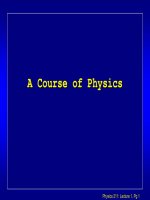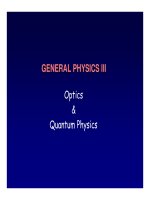- Trang chủ >>
- Khoa Học Tự Nhiên >>
- Vật lý
Tài liệu Chapter X Magnetic Field doc
Bạn đang xem bản rút gọn của tài liệu. Xem và tải ngay bản đầy đủ của tài liệu tại đây (788.11 KB, 50 trang )
3/5/2008 1
GENERAL PHYSICS II
Electromagnetism
&
Thermal Physics
3/5/2008 2
Chapter X
Magnetic Field
§1. Magnetic interaction and magnetic field
§2. Magnetic forces on a moving charged particle
and on a current-carrying conductor
§3. Magnetic field of a current – magnetic field calculations
§4. Amper’s law and application
3/5/2008 3
§1. Magnetic interaction and magnetic field
1.1 Magnetic phenomena:
Some history:
Magnetic effects from natural magnets have been known for a long
time. Recorded observations from the Greeks more than 2500 years
ago.
The word magnetism comes from the Greek word for a certain type of
stone (lodestone) containing iron oxide found in Magnesia, a district in
northern Greece.
Properties of lodestones: could exert forces on similar stones and
could impart this property (magnetize) to a piece of iron it touched.
Bar magnet: a bar-shaped permanent magnet. It has two poles: N and S
Like poles repel; Unlike poles attract.
We say that the magnets can interact each with other. This kind of
interaction differs from electric interactions, and is called magnetic
interaction
3/5/2008 4
We have known that the means of transfering interactions between
electric charges is electric field. By analogy to electric interaction we
introduce for magnetic interaction the concept of magnetic field which
is the means of transfering magnetic interactions:
A magnet sets up a magnetic field in the space around it and the
second magnet responds to that field.
The direction of the magnetic field at any point is defined as the
direction of the force that the field would exert on a magnetic north pole
of compass needle
The earth itself is a magnet.
Note that for the earth magnet:
the geographical pole ≠the magnetic pole
N
S
North geographic pole
South magnetic
pole
South geographic pole
North magnetic pole
N
S
3/5/2008 5
1.2 Magnetic field vector and magnetic field lines:
By analogy to electric field vector E we can introduce magnetic
field vector B :
+ The direction of magnetic field vector at each point in the space
can be defined experimentally by a compass
+ The mathematical expression for magnetic field vector (magnitude
and direction) will be defined below (the law of Biot and Savart)
Magnetic field lines can be drawn in the same manner as electric
field lines (direction and density)
NS
3/5/2008 6
Magnetic Field Lines of
a bar magnet
Electric Field Lines
of an Electric Dipole
NS
3/5/2008 7
Magnetic Monopoles ?
Perhaps there exist magnetic charges, just like electric charges. Such an
entity would be called a magnetic monopole (having + or - magnetic
charge).
How can you isolate this magnetic charge?
Try cutting a bar magnet in half:
• Many searches for magnetic monopoles no monopoles have
ever been found !
NS
Even an individual
electron has a
magnetic “dipole”!
N NS S
3/5/2008 8
Source of Magnetic Fields?
What is the source of magnetic fields, if not magnetic charge?
Answer: electric charge in motion!
e.g., current in wire surrounding cylinder (solenoid) produces very
similar field to that of bar magnet.
Therefore, understanding source of field generated by bar magnet
lies in understanding currents at atomic level within bulk matter
Motions of electrons on orbits and intrinsic motions produce
magnetic field.
Orbits of electrons about nuclei
Intrinsic “spin” of
electrons (more
important effect)
3/5/2008 9
• The force F on a charge q moving with velocity v through a region
of space with magnetic field B is given by:
F
x x x x x x
x x x x x x
x x x x x x
v
B
q
v
B
q
F = 0
v
B
q
F
§2. Magnetic forces on a moving charged particle
and on a current-carrying conductor:
2.1 Magnetic force on a moving charge:
BvqF
Magnetic Force:
(Lorentz force)
• In the formula B is measured in Tesla (T): 1T = 1 N / A.m
3/5/2008 10
Example 1:
Two protons each move at speed v (as
shown in the diagram) in a region of
space which contains a constant B field
in the -z-direction. Ignore the interaction
between the two protons.
What is the relation between the
magnitudes of the forces on the two
protons?
(a) F
1
< F
2
(b) F
1
= F
2
(c) F
1
> F
2
(a) F
2x
< 0 (b) F
2x
= 0
(c) F
2x
> 0
B
– What is F
2x
, the x-component of the force on the second
proton?
A
B
x
y
z
1
2
v
v
(a) decreases (b) increases
(c) stays the same
C
– Inside the B field, the speed of each proton:
3/5/2008 11
Two independent protons each move
at speed v (as shown in the diagram)
in a region of space which contains a
constant B field in the -z-direction.
Ignore the interaction between the two
protons.
What is the relation between the
magnitudes of the forces on the two
protons?
(a) F
1
< F
2
(b) F
1
= F
2
(c) F
1
> F
2
A
• The magnetic force is given by:
θqvBFBvqF sin
• In both cases the angle between v and B is 90!!
Therefore F
1
= F
2
.
B
x
y
z
1
2
v
v
3/5/2008 12
Two independent protons each move
at speed v (as shown in the diagram)
in a region of space which contains a
constant B field in the -z-direction.
Ignore the interaction between the two
protons.
What is F
2x
, the x-component of
the force on the second proton?
(a) F
2x
< 0 (b) F
2x
= 0
(c) F
2x
> 0
B
• To determine the direction of the force, we use the corkscrew rule
(or right-hand rule).
• As shown in the diagram, F
2x
< 0.
BvqF
F
1
F
2
B
x
y
z
1
2
v
v
3/5/2008 13
(a) decreases (b) increases
(c) stays the same
C
B
x
y
z
1
2
v
v
Two protons each move at speed v (as
shown in the diagram) in a region of
space which contains a constant B
field in the -z-direction. Ignore the
interaction between the two protons.
Inside the B field, the speed of
each proton:
Although the proton does experience a force (which deflects it), this force
always ⊥to v. Therefore, there is no possibility to do work, so kinetic
energy is constant and | v | is constant.
3/5/2008 14
1) Turn on electron ‘gun’
qVmv
2
2
1
qB
mv
R
2) Turn on magnetic field B
3) Rearrange in terms of measured values, V, R and B
22
2
BR
V
m
q
m
q
Vv 2
2
2
2
RB
m
q
v
and
Example 2: Determine the ratio of charge to mass for an electron ?
e
-
V
‘gun’
R
Experiment gave this ratio = 1.76 10
11
C/kg
3/5/2008 15
• The scheme for the “gun”
• The principle of a selector:
3/5/2008 16
2.2 Magnetic force on a current-carrying conductor:
Consider a current-carrying wire in the
presence of a magnetic field B.
There will be a force on each of the charges
moving in the wire. What will be the total force
dF on a length dl of the wire?
Suppose current is made up of n charges/volume
each carrying charge q and moving with velocity v
through a wire of cross-section A.
BlIdFd
BvqdlnAFd
)(
nAvq
dt
qdtnAv
dt
dq
I
)(
Bvq
Force on each charge =
Total force =
Current =
N
S
The case for a straight length of wire L carrying
a current I, the force on it is:
BLIF
3/5/2008 17
2.3 Magnetic force and torque on a current loop:
Consider loop in magnetic field as on
right: If field is to plane of loop, the
net force on loop is 0!
• If plane of loop is not to field, there will
be a non-zero torque on the loop!
B
x
.
F
F
x x x x x x x
x x x x x x x
x x x x x x x
x x x x x x x
x x x x x x x
B
I
F
F
F
F
Force on top path cancels force on
bottom path (F = IBL)
Force on right path cancels force
on left path. (F = IBL)
3/5/2008 18
• What is the force on section a-b of the loop?
a) zero b) out of the page c) into the page
• What is the force on section b-c of the loop?
a) zero b) out of the page c) into the page
4) What is the net force on the loop?
a) zero b) out of the page c) into the page
A square loop of wire is carrying
current in the counterclockwise
direction. There is a horizontal uniform
magnetic field pointing to the right.
ab: F
ab
= 0 = F
cd
since the wire is parallel to B.
bc: F
bc
= ILB RHR: I is up, B is to the right, so F points into the screen.
By symmetry:
da bc
F F
n et ab b c cd d a
0F F F F F
Example:
3/5/2008 19
Calculation of Torque:
• Suppose the loop has width w (the side
we see) and length L (into the screen).
The torque is given by:
Note: if loop B, sin= 0 = 0
maximum occurs when loop parallel to B
Frτ
AIB sin
F = IBL
where
A = wL = area of loop
sin
2
2 F
w
τ
r ×F
F
r
B
x
.
w
F
F
3/5/2008 20
• We can define the magnetic dipole moment of a current loop as
follows:
+ direction: to plane of the loop in
the direction the thumb of right hand
points if fingers curl in the direction of
current.
+ magnitude:
AI
• Torque on loop can then be rewritten as:
• Note: if loop consists of N turns,
= NAI
AIB sin
Bμτ
B
x
.
F
F
=
N
μ
Concerning to magnetic dipole
moment we have an analogue:
(N loops N bar magnets)









